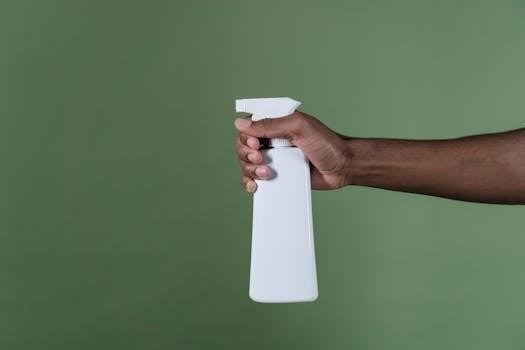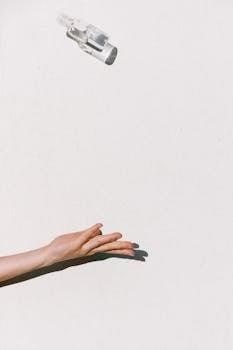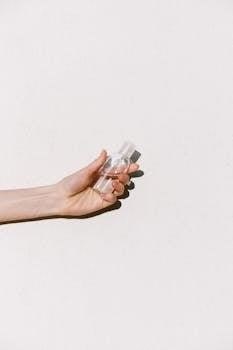Tommee Tippee Sanitizer Instructions⁚ A Comprehensive Guide
Tommee Tippee sterilizers offer parents a convenient way to ensure their baby’s feeding equipment is clean and safe. This guide provides comprehensive instructions for using these sterilizers effectively.
Tommee Tippee sterilizers are designed to protect your baby’s health by eliminating harmful bacteria from bottles and feeding accessories. These sterilizers use steam to ensure a high level of hygiene, effectively killing 99.9% of germs.
The importance of proper sterilization cannot be overstated, as it minimizes the risk of infections and illnesses in infants. Tommee Tippee sterilizers offer a convenient and efficient solution for busy parents.
Using a Tommee Tippee sterilizer provides peace of mind, knowing that your baby’s feeding equipment is thoroughly sanitized. These devices are designed for use with Tommee Tippee bottles and accessories, ensuring compatibility and optimal performance.
Regular sterilization is crucial for maintaining a healthy feeding environment for your baby. With a Tommee Tippee sterilizer, you can easily and quickly sanitize bottles, nipples, and other accessories, making it an essential tool for new parents.
Tommee Tippee sterilizers are easy to use and maintain, making them a practical addition to any nursery. By following the instructions carefully, you can ensure the safety and well-being of your baby.
Tommee Tippee Sterilizer Models Overview
Tommee Tippee offers a range of sterilizer models designed to meet different needs and preferences. Among the popular options are the Electric Steam Sterilizer, the Microwave Sterilizer, and the Advanced Electric Sterilizer and Dryer.
The Electric Steam Sterilizer is a convenient countertop unit that uses steam to sanitize bottles and accessories in just a few minutes. It’s designed to hold multiple bottles and feeding accessories, streamlining the sterilization process.
The Microwave Sterilizer provides a quick and portable solution for sanitizing on the go. It uses the power of your microwave to effectively eliminate bacteria from bottles and accessories.
For added convenience, the Advanced Electric Sterilizer and Dryer not only sterilizes but also dries your baby’s bottles, reducing the risk of contamination and saving you time. This model is particularly favored for its efficiency and hygiene.
Each Tommee Tippee sterilizer model is designed with user-friendliness in mind, making it easy for parents to maintain a clean and safe feeding environment for their babies. Understanding the features of each model can help you choose the one that best fits your lifestyle.
Preparing for Sterilization
Before using your Tommee Tippee sterilizer, proper preparation is essential to ensure effective sanitization. Begin by thoroughly washing all bottles, nipples, and accessories in warm, soapy water. Use a bottle brush to remove any milk residue or debris from the inside of the bottles. Rinse everything completely under running water to eliminate any traces of soap.
Disassemble all bottle parts, including nipples, collars, and caps, to ensure that every surface is exposed to the sterilizing steam. Check each item for any damage or wear, and discard any that are cracked or broken.
Washing and rinsing are important because the sterilizer is meant to kill germs and bacteria, not to clean bottles. Food residue that isn’t cleaned off bottles prior to sanitizing can encourage bacterial growth and impact the effectiveness of sterilization.
Also, ensure the sterilizer itself is clean before each use. Wipe down the interior with a damp cloth to remove any mineral deposits or residue. Following these steps will help you maintain a hygienic environment for your baby’s feeding equipment.
Step-by-Step Instructions for Electric Steam Sterilizers
Using a Tommee Tippee electric steam sterilizer is a straightforward process. First, ensure the unit is placed on a flat, heat-resistant surface. Pour exactly 80ml of water into the sterilizer base, using a Tommee Tippee bottle for accurate measurement if available. Overfilling can prolong the cycle.
Next, load the sterilizer with your pre-cleaned bottles, nipples, and accessories. Place the bottles upside down in the designated holders. Ensure that all items are disassembled and that openings face downwards to allow steam to circulate effectively. Avoid overcrowding to ensure each item is properly sterilized.
Once loaded, secure the lid tightly. Plug the sterilizer into a power outlet and switch it on. Press the power button to start the sterilization cycle. The sterilizer will automatically turn off when the cycle is complete, usually after about 5 minutes.
Allow the unit to cool for at least 3 minutes before opening. Be cautious of escaping steam. Remove the sterilized items carefully, using tongs to maintain sterility, and assemble them as needed.
Using the Correct Amount of Water (80ml)
Accurate water measurement is crucial for the proper functioning of your Tommee Tippee sterilizer. Always use exactly 80ml of water in the base of the unit for each sterilization cycle. Using too little water can result in incomplete sterilization, leaving your baby’s feeding equipment at risk of contamination. Conversely, adding too much water can extend the sterilization cycle time and potentially damage the unit over time.
Many Tommee Tippee bottles feature a convenient 80ml measurement mark, simplifying the process; If your bottles lack this marking, use a separate measuring device to ensure accuracy. Distilled or purified water is recommended to minimize mineral buildup, which can affect the sterilizer’s performance and lifespan.
Consistent and accurate water usage ensures optimal steam generation, effectively eliminating harmful bacteria and viruses from bottles, nipples, and accessories. Regularly check the water level after each cycle and descale the sterilizer as needed to maintain its efficiency. Ignoring the water level requirement can lead to ineffective sterilization and potential health risks for your baby.
Loading the Sterilizer⁚ Bottles and Accessories
Proper loading of your Tommee Tippee sterilizer is essential to ensure all items are thoroughly sterilized; Begin by disassembling all bottles into their individual components⁚ bottles, nipples, screw rings, and caps. Wash each part thoroughly with warm, soapy water and rinse them completely before loading.
Place the bottles upside down in the designated bottle holders within the sterilizer. Ensure the openings face downwards to allow steam to circulate freely inside. Arrange smaller items such as nipples, pacifiers, and breast pump parts in the provided trays or compartments. Avoid overcrowding the sterilizer, as this can impede steam circulation and compromise sterilization effectiveness.
Make sure that all items are positioned in a way that steam can reach all surfaces. Refer to the sterilizer’s manual for specific loading diagrams and recommendations. It’s generally advised to keep bottle hoods off during sterilization to prevent them from trapping moisture. After sterilization, reassemble the bottles with clean hands on a clean surface.
This attention to detail ensures that every part is properly sanitized, protecting your baby from harmful bacteria.
Operating the Sterilizer⁚ Cycle Duration
The Tommee Tippee sterilizer’s cycle duration is a crucial aspect of ensuring effective sterilization. Typically, the electric steam sterilizers operate on a cycle of approximately 5 minutes, though specific models might vary slightly. Always refer to your sterilizer’s manual for precise timing.
Once the sterilizer is properly loaded and the correct amount of water (usually 80ml) has been added, simply press the power button to initiate the cycle. The sterilizer will automatically heat the water, creating steam that sanitizes the bottles and accessories.

During operation, avoid opening the sterilizer, as this interrupts the cycle and compromises sterility. A light usually indicates when the cycle is complete. Allow the unit to cool for a few minutes before opening to prevent burns from escaping steam.
Ensure the sterilizer is placed on a flat, heat-resistant surface away from children. Note that cycle times can sometimes be affected by factors like water mineral content or voltage fluctuations. However, deviations should be minimal if the sterilizer is functioning correctly and used as directed. Proper operation within the recommended cycle duration guarantees the elimination of harmful bacteria.
Cleaning and Maintenance⁚ Descaling Instructions
Regular cleaning and maintenance, particularly descaling, are essential for optimal Tommee Tippee sterilizer performance. Mineral deposits from tap water can accumulate over time, affecting the sterilizing process. Descaling removes these deposits, ensuring efficient operation and prolonging the lifespan of your sterilizer.
To descale, first unplug the sterilizer and allow it to cool completely. Then, empty any remaining water. Prepare a descaling solution using a commercially available descaler suitable for steam sterilizers, or a mixture of white vinegar and water (follow the descaler’s instructions or use a 1⁚1 vinegar-water ratio).
Pour the solution into the sterilizer base, ensuring it covers the heating element. Let it sit for the recommended time (usually 30 minutes, but check the descaler’s guidelines). After soaking, discard the solution and rinse the sterilizer thoroughly with clean water to remove any residue.
Wipe the interior with a damp cloth. For stubborn deposits, repeat the process. Regular descaling (every 4-6 weeks, or more frequently in hard water areas) keeps your sterilizer working effectively and ensures your baby’s bottles are properly sanitized. Always consult your sterilizer’s manual for specific descaling recommendations.
Cooling and Drying After Sterilization
Once the sterilization cycle is complete, allow the Tommee Tippee sterilizer to cool down for at least 5 minutes before opening. This cooling period is crucial for safety, as the water and steam inside are extremely hot and can cause burns. After the cooling period, carefully open the sterilizer lid, being mindful of any residual steam that may escape.

Remove the trays and any remaining water from the base of the unit. It’s essential to discard this water after each cycle to prevent the buildup of mineral deposits and bacteria. To dry the sterilized items, you can either air dry them or use a clean, lint-free cloth. If air drying, place the bottles and accessories on a clean surface, such as a drying rack designed for baby bottles.
Ensure adequate ventilation to facilitate the drying process. Alternatively, you can use a clean cloth to gently pat the items dry. Avoid using a dish towel, as it may harbor bacteria. Once the bottles and accessories are completely dry, assemble them and store them in a clean, dry place until they are needed. Remember that items remain sterile for up to 24 hours if the sterilizer lid remains closed.

Safety Precautions⁚ Important Safeguards
When using a Tommee Tippee sterilizer, several safety precautions must be followed to prevent accidents and ensure proper operation. Always place the sterilizer on a flat, heat-resistant surface, away from flammable materials. Ensure the sterilizer is out of reach of children to prevent burns or other injuries. Never open the sterilizer during operation, as it contains boiling water and steam.
After the cycle, allow it to cool for at least 5 minutes before opening. Be cautious of escaping steam when opening the lid. Only use the sterilizer with the recommended amount of water (80ml) to prevent malfunctions or damage. Always unplug the sterilizer when not in use and before cleaning. Regularly descale the sterilizer to maintain its performance and prevent mineral buildup.
Do not immerse the sterilizer base in water or any other liquid. Use a damp cloth to clean the exterior. Inspect the power cord regularly for damage, and do not use the sterilizer if the cord is frayed or damaged. Only use Tommee Tippee bottles and accessories designed for sterilization in the unit. Avoid overloading the sterilizer, as this can affect its performance. Following these safeguards will ensure safe and effective sterilization.
Troubleshooting Common Issues
Encountering issues with your Tommee Tippee sterilizer can be frustrating, but many problems have simple solutions. If the sterilizer isn’t turning on, first ensure it’s properly plugged into a working outlet. Check that the power switch is in the “on” position. If the cycle takes too long, verify that you’re using the correct amount of water (80ml). Too much water can extend the sterilization time.
If the sterilizer smells bad, it may need descaling. Follow the descaling instructions in the manual. Mineral buildup can cause odors and affect performance. If bottles are not sterilizing properly, ensure they are thoroughly cleaned before loading them into the sterilizer. Make sure bottles and accessories are arranged to allow steam to circulate freely.
If the sterilizer leaks, check that all components are correctly assembled. Ensure the lid is properly sealed. If there’s excessive steam escaping, make sure the lid is securely in place. If the sterilizer stops mid-cycle, it may have overheated. Allow it to cool down before restarting. If problems persist, consult the Tommee Tippee website or contact customer support for further assistance. Regularly maintaining your sterilizer can prevent many common issues.
Storage and Continued Sterility (24 Hours)
Tommee Tippee sterilizers offer the convenience of keeping your baby’s bottles and accessories sterile for up to 24 hours, provided the lid remains securely closed. To ensure continued sterility, avoid opening the sterilizer unnecessarily. Each time the lid is opened, the sterile environment is compromised, and bacteria can re-enter.
After the sterilization cycle is complete, allow the items to cool inside the sterilizer before handling them. This minimizes the risk of contamination. When you need to use a bottle or accessory, wash your hands thoroughly before removing it from the sterilizer. If any item is not used within 24 hours, it must be resterilized to ensure it is safe for your baby.
Store the sterilizer in a clean, dry place when not in use. This helps prevent the growth of mold and bacteria. Regularly clean the sterilizer according to the manufacturer’s instructions to maintain its hygiene. Remember, proper storage and handling are crucial for maintaining the sterility of your baby’s feeding equipment. Always prioritize your baby’s health and safety by following these guidelines diligently.

